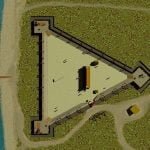
On February 15, 1562 the government of France dispatched Captain Jean Ribault with a small fleet to explore the South Atlantic Coast, claim it for the King of France, and identify potential locations for colonies. Unlike colonial expeditions sponsored by Spain and England in that century, the French expedition was extremely well planned, at least on paper. It was financed by the French Crown, whereas Spanish and English colonial attempts were privately capitalized. The members of the expedition included all skills necessary to survive in the New World, including carpenters and ship builders. Admiral de Cologny intended French Florida to become a major center of ship-building, because of the inexhaustible supply of wood on the Southeast. The colony would thrive from the profits of ship-building and not be dependent on support from the French Crown for very long. That was the plan, at least.
The expedition reached the coast of North American around April 15. De Laudonniére’s memoirs do not give a specific date. The place is called a cape or headland that consisted of a white sandy beach and a horizon defined by trees. This well could have been one of the larger barrier islands on the South Atlantic coast. The French called this geographical landmark, Cape François. De Laudonniére said that it was at about 30 degrees latitude. Almost all scholars assume that Cape François was Cape Canaveral, however, Cape Canaveral is at 28.47 degrees. Furthermore, a later passage in de Laudonniére’s memoirs describe Cape Canaveral as a different geographical feature, farther south than they had sailed.
Cape François may have been the entrance to St. Augustine. It has a latitude of 29.97ᵒ which is very close to 30ᵒ. The outer barrier island of St. Augustine Bay could have appeared to be a cape.
On May 1, 1562 the expedition reached the mouth of a large river where sizable Native populations lived. The French called the river, the River May. Ribault had brought along with him three marble columns engraved with the coat of arms of the King of France. He placed one of these columns at the mouth of this river, which contemporary scholars assume to be the St. Johns River. Ribault’s fleet then sailed northward along the coast, mapping the islands and river outlets.
The expedition reached what is currently believed to be Port Royal Sound, SC around May 15, 1562. De Laudonniére’s memoirs do not give a specific date. The natural harbor was first discovered by two barques that had become lost in the fog. After exploring the more southerly of the two rivers that joined at the tip of a peninsula, Ribault sailed back to the tip of an island which protruded into the sound and erected a second marble monument. The expedition then disembarked and established camp on the peninsula.

